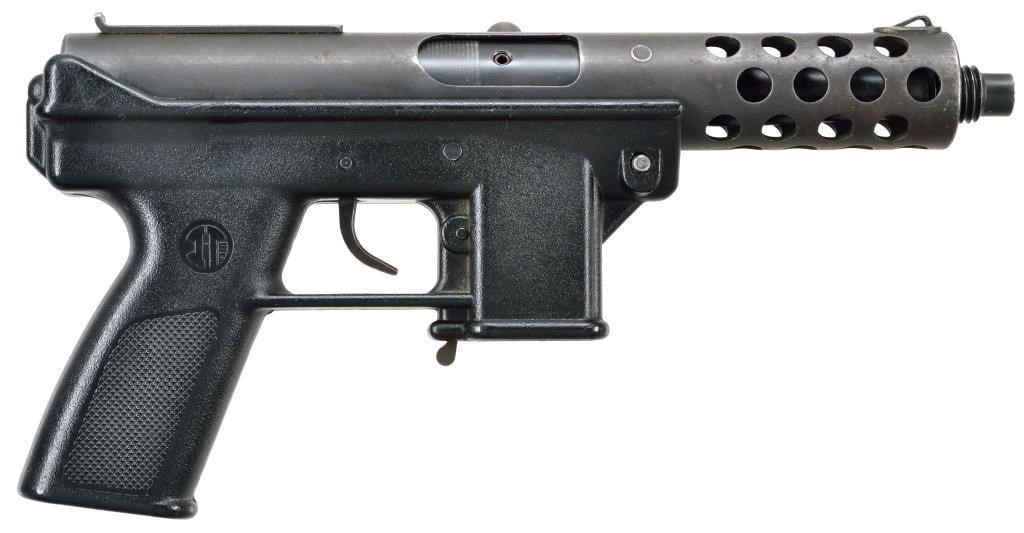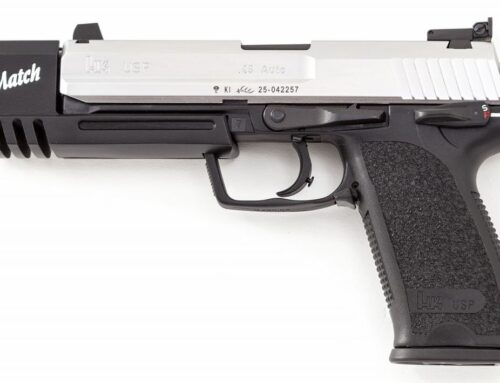This month we’re going back to the mid 1980s when a designer named George Kellgren hatched the idea for a new firearm which ended up having quite a reputation. In America the TEC-9 has gained a bad rep for being used in street crimes but there’s much more to the story of this curious and fascinating system.
The TEC-9’s origins begin with a Swedish firearms manufacturer known as Interdynamic AB with the initial model known as the MP-9 which was an inexpensive submachine gun intended for military use. Failing to gain any traction on this front it soon shifted toward the civilian market where Kellgren brought it over to the U.S. under the subsidiary company branded Interdynamic USA. The first models did away with the collapsible stock and vertical foregrips but retained an open bolt operation for a short period until regulation forced a change to a closed bolt design. At this point it was known as the KG-99.
Being called out for the open bolt design is only one of several areas where this firearm ran into issues with ever evolving laws. The TEC-9 was rather unfortunate in being called out for a number of different reasons such as having extended magazine capacities, magazines which loaded in front of the grip, barrel shrouds, and threaded barrels. In some instances it had become something of a one stop shop for all of the “bad” features which might be found on a handgun.
In 1989 it was specifically banned in the state of California. One year later it came back under the name TEC-DC9 for the next four years, DC standing for “Designed for California.” A few minor cosmetic changes such as the location of its sling loops had been made but functionally it remained the same as before. Then again in 1993 California amended their banned list to include any handguns having features such as barrel shrouds. At the time there were very few pistols with such a feature.
In 1994 the entire TEC-9 series were banned country-wide along with nearly twenty others, forcing an end to their production. Again Intratec didn’t stay idle for long, by the next year a new model known as the AB-10 (standing for After Ban) came to market. This version did without the heat shield and threaded barrel and shipped with ten round magazines, although earlier models capable of holding more continued to work.
Between 1988 and 2000 there was also a similar looking pistol chambered in .22LR known as the TEC-22 and later Sport-22 as well as the TEC-25 which was a .25 ACP chambered variant.
In 2001 Intratec was dissolved and all production ceased though its memory lives on in several states where it remains banned by name. While this may have marked the end of this particular firearm and the closure of Intratec, Kellgren’s work is far from over. He had since moved on to create another company known as Kel-Tec.
As can be expected the TEC-9 series have become something of collector pieces because of their iconic profile, limited availability and that many have not survived over the decades. Between 1984 and 2001 around 257,400 units had been manufactured. Perhaps their biggest downfall from a design standpoint is the use of polymer for the lower receiver which had a reputation for breaking and rendering the firearm unusable, particularly in earlier models. Going off of Wikipedia, the earlier models were only intended to use 115 grain bullets and heavier or hotter rounds would force the back of the receiver into the frame and cause cracking. Later models seem to have fixed this by having threaded end caps.
The model which I was able to review (and can be found on display right here at the Range of Richfield) is marked TEC-9 and is a closed bolt example, probably the single most iconic variation out of the half dozen models across the gun’s lifespan.
Certainly compared to a regular handgun the TEC-9 is a beast of a gun which immediately poses the question of how are you supposed to hold it? The earliest submachine guns had that vertical grip attached to the heat shield but after becoming a pistol this option disappeared. You can hold it by the front of the magazine well which feels awkward at best, or hold it like a large pistol. Grabbing it by the heat shield may be an option as well but I didn’t try it with this hold.
The weight of these firearms ranged between 2.7 and 3 pounds with all of the weight coming from the stamped steel tubing, barrel and bolt up top. The polymer lower by itself is ridiculously light with very few metal pieces. The sear looked like a piece of scrap metal from a hardware store, complete with a few small spots of corrosion.
Despite the lowers feeling cheap as can be the internals on a TEC seem quite intelligent, I only first began to appreciate the design after getting a closer look at how they operate on relatively few parts. Being a simple blowback design there’s no tricky locking system or moving parts involved, only a reciprocating charging handle mounted at an upward angle on the left side. The safety is simply a matter of pushing the charging handle in which both locks the bolt and disconnects the trigger.
Iron sights are crude but really not bad to look through. The notch and post are fairly wide but precision shooting had never been the TEC’s intention. They utilize double stack double feed stick magazines located in front of the trigger guard and could be had in a number of capacities from 10 rounds to 20, 32, 36, and 50 rounds, as well as a 72 round drum. The magazine catch is very much like an AK or a CZ Scorpion as a small ambidextrous tab which is easily hit with a thumb while grabbing hold of the mag body. In fact, all of the controls worked easily. Despite the short bolt throw and heavier blowback spring the TEC-9 is not a difficult firearm to charge.
Disassembly begins by removing a non-captive cross pin from the front not unlike an AR-15 then gently pulling up and forward to free a rear post from the back of the polymer frame. The end cap has a center post which fits into the polymer lower and I suspect this might be one of the areas where they could break as if you pull the upper receiver at too steep of an angle it will put a lot of stress on this area.
Inside the TEC-9 has an offset guide rod and a shorter striker rod and spring with very few parts overall. Another area known to suffer over time is the rubber buffer behind the plate which holds both of these rods, these pads have a habit of becoming brittle. Trying to find a full parts diagram has proven to be difficult but from what I can tell the gun without a magazine only has around thirty parts to it.
Range time was very limited, I was only able to put a few rounds through the TEC-9 but they proved to be enough. The shooting experience is vastly different from most guns on the market, again beginning with figuring out where to put your off-hand. I tried holding the front of the mag well but found it quite awkward and soon held it like any other pistol in a two handed grip.
The trigger pull was quite long yet surprisingly fluid, however difficult to predict exactly where or when it would break. Reset required nearly its full range of motion. The trigger itself is also quite narrow and somewhat rough along the edges. With the blowback design and heavy top end the TEC loves to jump backward under recoil but does not like to return to target. Through the recoil this thinner trigger had a tendency to bite into my index finger, after just the few shots I could feel where it had been catching me.
Recoil itself felt more of a quick push than a typical handgun snap and wasn’t bad at all but when holding onto only the back there’s effectively nothing to counter muzzle flip. Operated this way the TEC is not good for follow-up shots.
The Intratec series of firearms are quintessential 1980’s which to this day have rarely seen any form of resurrection (although Swiss company B&T had done a limited run of some firearms which bore a strong resemblance.) I highly doubt these guns would survive in today’s market with their original appearance and features, although I wouldn’t immediately write them off.
With the resurgence of pistol caliber carbines I find my imagination running wild about a redesigned TEC-9 for this century. Modern polymer construction would make the weakest points much more robust. A Picatinny mount for braces or stocks, an M-Lok barrel shroud, better sights with an optics rail up top and perhaps compatibility with newly manufactured magazines, there could be a whole new life for the system especially if prices could be kept down. As a braced pistol or a short barreled rifle I feel that they could do quite well and offer a bit of nostalgia alongside an inherently efficient design. Having fired one I’m tempted to say they would have a better recoil impulse than some of the newer PCC’s, a new TEC could give the Scorpion a run for the money.
With what TEC-9s still remain they do seem destined to be collection pieces and safe queens but given the overall shooting experience I’d say this is the best place for them. Replacement parts don’t exist and age has not done their more fragile parts any favors but I find simply being able to look at and hold one gives me enough of the Intratec experience all on its own. Perhaps more importantly, the complicated history of this firearm led us to a brand new company which has since brought some unique innovations to the industry.








